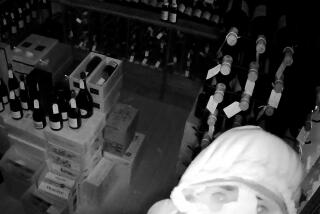How to Order Wine Like a Connoisseur
- Share via
In a restaurant, the wine snob is a boor.
He tests the knowledge of the staff and shames anyone who makes a slight slip; he rejects bottles of wine on the slightest whim; he bristles that storage of the bottle he’s having has been less than perfect; he fumes about the poor quality of the service and the glassware, and he chats endlessly about the inadequacy of the wine list because it doesn’t have any Chateau Eau-Chaud.
The true wine connoisseur treats dining out with a sense of adventure and daring, willing (indeed, eager) to try an off-vintage of a wine; prepared to accept with grace an inaccuracy by the waiter, and not offended when the Chardonnay is served near-frozen.
But dining out in the mode of the self-assured connoisseur is no easy act. It requires an understanding of the ground rules of restaurant wine service. And that information is rarely supplied in wine books.
The following is a quiz that sets up scenarios that confront diners in restaurants. In each case, answer what you would do to the situations posed.
But first, a clue: Real wine connoisseurs are not jerks. The basic rule in the game of wine connoisseurship is to treat the ordering of wine as an interesting and enjoyable sport, not that isn’t played to the death, but for the spirit of it.
Situation: The waiter plops an enormous tome in your lap, gives you a few minutes to choose a wine, then returns with a haughty look, seeking your choice. You don’t know which of the hundreds of wine choices you want, and the thought of trying to pronouce Musigny fills you with dread.
Solution: Ask the waiter. Say, “What can you recommend?” Some restaurants have sommeliers who know every wine on the list and can make a suggestion. That suggestion should be based on the food you’re ordering. If a suggestion is made without the staff first finding out what you’re eating, be wary of the suggestion.
Watch the staff for any hesitation, any indication they seem unsure of themselves. In such cases, it’s often safer to simply opt for a wine you’re familiar with.
Situation: The waiter brings the bottle you’ve ordered and holds it out to you, to show you the label. What do you do?
Solution: Don’t just nod at it. Look carefully. Is it the vintage you ordered? If not, send it back--nicely. Is it the right producer? The right designation (Special Selection, Private Reserve)? Is the cork still in the bottle? (It should be; wine should be opened in front of the patron; if a bottle of wine is brought to the table already opened, reject it on the spot.)
If it’s the right wine, say so, with a nod or, “That’s fine.”
Situation: The cork is pulled and the waiter puts it on the table in front of you.
Solution: Leave the cork alone, if you wish. Or pick it up and squeeze it. Or smell the damp end. But the condition of the cork is no indication of the condition of the wine; I have had wines that smelled corked but the musty quality was not evident in the cork, and I have had wines that smelled and tasted fine, but which had corks in them that smelled strange.
I heard of a wine lover who once played a little trick on a particularly obsequious waiter. He picked up the proferred cork, took a healthy bite out of it, and then said dryly, “Needs more time in the bottle.” It unnerved the waiter.
Situation: the waiter has trouble getting the cork out of the bottle. The cork splits, half of it falling into the bottle.
Solution: If the waiter succeeds in getting the cork out of the bottle, accept the wine. Unless the cork is spoiled, the wine won’t be hurt by a little of the cork dust that fell into the wine. If the cork remains in the wine, bobbing around, the waiter should suggest removing the bottle and bringing another. Either that or he’ll ask if you wish to keep this bottle.
Situation: The waiter pours a small sip of wine into your glass and stands back, waiting for you to do something.
Solution: Take your time. You’re in no hurry here. Lift the glass by the stem and swirl it slightly, to run the wine up on the side of the glass and release more of the aroma. Sniff it. Then sip.
Does the wine have a clean, appropriate aroma? Or is there a strong odor of sulfur, vinegar, or some other element that shouldn’t be there?
If the sniff and taste are fine, nod to the waiter, or say, “That’s fine.”
If there is an obvious flaw, then suggest to the waiter that there might be something wrong with the wine. If you know what the flaw is, note the flaw specifically and tell the waiter you’d like to make another selection.
An important point here: Under rare circumstances should a wine be rejected. Send wine back only for legitimate flaws, not merely because you don’t like the wine. (For example, with older wines, a problem that happens occasionally is oxidation. Some oxidation is natural in older wine, and if found in an older wine should not be cause to reject the wine out of hand.)
Thus if you chose a 1980 Chardonnay from a wine list and the wine isn’t as fresh as you expected, keep the wine. You should have known that such a bottle wouldn’t be as fresh as a 1987 Chardonnay.
Restaurateurs’ No. 1 complaint about wine service is wine being rejected by customers for the wrong reason.
When rejecting a bottle of wine, be as cordial as possible and allow restaurant personnel to taste the wine and concur. And do so before you consume half the bottle.
Situation: The wine glasses are small, or curiously shaped.
Solution: Ask the waiter if the restaurant has larger or better wine glasses. Often I have found that the jelly jars on the tables are for the average customer, but that special glassware is available for finer quality wines if you simply ask.
Situation: The red wine is served too warm.
Solution: Ask for an ice bucket. I realize that ice buckets are for white wines and that red wines should not be chilled, but often it’s the only solution for a bottle of red wine that’s been stored in the kitchen. (But watch the bottle. The only red wine that benefits from a chilling is Beaujolais.)
Situation: The white wine is served at an almost cryonic temperature, making the aroma of the wine more a rumor than a fact.
Solution: Few white wines should be served icy-cold. Champagne and some Rieslings may benefit from significant chilling, but table wines like Chardonnay and Sauvignon Blanc rarely need to be below 50 degrees. If the wine is too cold, ask the waiter to leave the bottle out of the ice bucket and allow it to warm.
Other pointers:
You may pour wine into your glass, or into the glasses of others at your table if the staff ignores you and doesn’t pour your wine for you. There is no law, or ethical prohibition, against your picking up your bottle of wine and pouring. In fact, I recommend it if the waiter overfills your glass (a common error).
If you order an older red wine with some sediment, or a very young red wine that you want aerated, you may want it decanted. If so, ask the staff if the restaurant can decant the wine for you.
If you order a glass of sherry or port and it’s brought to the table in one of those little v-shaped glasses that can’t be swirled, ask for a standard wine glass and transfer the wine into it. The larger glass will (a) tell you how much wine they are really serving in the v-shaped glass, and (b) permit you to get a better aroma from the wine by swirling.
If you order a bottle of champagne and they bring to your table some of those flat, saucer-shaped glasses called coupes , ask for real champagne flutes. If the restaurant doesn’t have flutes, a standard tulip-shaped wine glass is better than the coupe , which serves only to dissipate the bubbles rapidly.
More to Read
Eat your way across L.A.
Get our weekly Tasting Notes newsletter for reviews, news and more.
You may occasionally receive promotional content from the Los Angeles Times.










